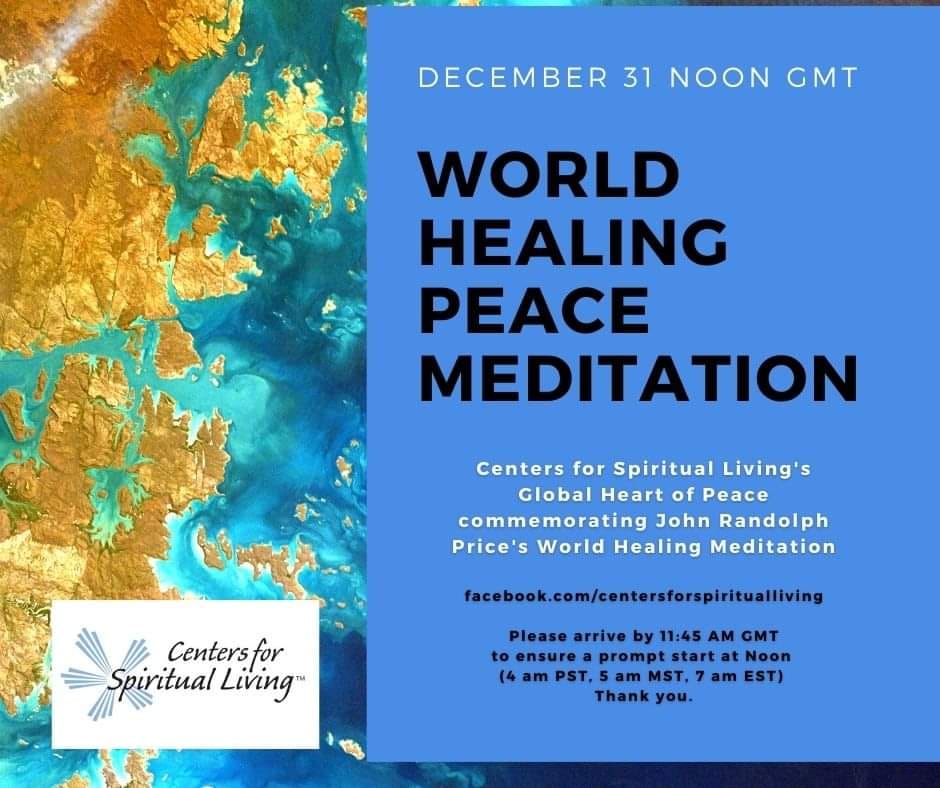
We are imbued with the ability to use the most powerful healing force in the universe: Love. It cannot be destroyed. It can be ignored. By denying its power, we cause ourselves and others pain. Embracing it is the only answer. Through the power of love, we can release ourselves from history’s entanglements and begin again. Love heals and makes whole.
Embarking on this transformative journey of shifting from individual moments of peace to continuities of peace, we must release attachment to how it’s always been, how we want it to appear, and ready ourselves so that Divine Possibility can have its way with us. An ancient Zen story provides guidance. It tells about a university professor who went to visit a famous Zen master. While the master quietly served tea, the professor talked about Zen. The master poured the visitor’s cup to the brim, and then kept pouring. The professor watched the overflowing cup until he could no longer restrain himself. “It’s full! No more will go in!” the professor blurted. “This is you,” the master replied, “How can I show you Zen unless you first empty your cup.” We must empty ourselves so that we are available to new learning and new experiences.
We are always at choice: the choice of how we are to be in each and every situation, the choice to be a conscious activity of God, the choice to apply spiritual principles to every circumstance, the choice to remember that the Truth that we know within must express into and as form, as circumstance, the choice to simply perpetuate our mistakes or learn from them and manifest our global vision of a world that works for all.
The Heart of Peace Initiative invites you to be a catalyst for global healing and sustainable peace, transforming moments of peace to continuities. You are encouraged to experiment with being a conscious presence as peace in a variety of settings and being kind and respectful when circumstances might lure you to be otherwise. We welcome you to meditate with us weekly on Facebook for Collective Peace Meditation at 1:00 PM (US Mountain Time) and for our array of other peace practices throughout the year.
Start 2023 by attending the World Healing Peace Meditation at 12:00 PM GMT December 31, 2022 (7am Eastern) on Center for Spiritual Living, Heart of Peace, Facebook Live. https://www.facebook.com/centersforspiritualliving/.
This blog post is the expressed opinion of its writer and does not necessarily reflect the views of Tysons Interfaith or its members.

By: Reverend Trish Hall, Centers for Spiritual Living Metro
It serves no purpose to deny what is happening globally and locally. Unless we acknowledge that there is a problem, we are powerless to make changes. How do we walk the tightrope of being fully engaged, committed to transforming the problem, yet not lose ourselves in the problem so that we become a force of separation? The passion that ignites our desire to manifest a world that works for everyone, can all too easily become divisive rather than unifying. Spirit stirs us to recognize that which needs to change, to seek solutions, to be impassioned to cause change, and to do so in ways that unite rather than separate us.
We receive conflicting messages: we must “feel it to heal it,” yet warned, “That which you focus upon expands in your experience.” Recognizing what needs to be changed demands that we look objectively at ourselves and circumstances. Simultaneously, we must feel it and sense it deeply, in order to muster the energy to be a cause for change yet not get so consumed by it that we lose perspective and become ineffective. We must place our focus on healing – to call forth the Divine Truth that shifts human experience at the level of cause. Divine Truth does not deny circumstances. It provides the means to effect lasting change of circumstances. It diminishes the human propensity to get distracted and waste energy on behaviors that widen rifts and entrench the sense of separation. It calls us to be healers – unifiers that dissolve the sense of separation.
So what is “healing”? The simple answer is to make whole. We must reunite our divided nature, releasing our fixation on what is wrong with the world and opening to pure potentiality – to accepting responsibility for doing our part to heal ourselves and the world. Sometimes in the midst of chaos, it is hard to see “Truth beyond appearances.” Sometimes, it is hard to remember when surrounded by alligators, that we are there to drain the swamp – to remember it is the Truth that sets us free from the alligators.
Ernest Holmes declared, “We have within us, a power that is greater than anything we shall ever contact in the outer, a power that can overcome every obstacle in our life and set us safe, satisfied and at peace, healed and prosperous, in a new light, and in a new life.” Simply because we have it is no assurance that we use it for good purpose – that is a matter of choice. How then do we choose to be? Do we use this power peacefully, as compassion, healing of strife and global chaos or do we remain imprisoned by beliefs that global peace is not possible because it has not yet been experienced? Do we take responsibility for our past mistakes, learn from them, and redirect our thoughts and actions? Do we uproot our misplaced faith in the inevitability of that which is not desired, or do we embrace the power within and be catalysts for change – catalysts for peace?
It is time to subdue all inner conflict by giving no further attention to the many distractions – the side issues that divert us from the fulfillment of our goal. We achieve this by engaging all our thoughts and feelings in constructive, creative, and productive consciousness – by being peace.
Please consider joining us or the annual World Healing Meditation that commences precisely at 12:00 AM GMT (7:00 AM Eastern) on December 31st. You can do this individually, or in-person groups or join the Heart of Peace Initiative which provides an hour of inspiration including affirmations, meditation and readings focused on the realization of global peace, healing all aspects of the world, revealing peace at: facebook.com/events/716551799681145

Nelson Mandela: “Peace is not just the absence of conflict; peace is the creation of an environment where all can flourish regardless of race, color, creed, religion, gender, class, caste or any other social markers of difference.”
Deep within their beings, John Randolph Price and his wife, Jan, understood true Peace. They envisioned millions of people around the planet joining together in a “global mind-link” to heal the world and reveal peace, so they launched the World Healing Day, December 31, 1986. Their concept was clear – a moment in time in which the consciousness of millions would be linked in a single focus: A worldwide, congruent embodiment of healing and harmonizing Planet Earth. The power of such clarity in any moment is unstoppable. Recognizing the challenge of sustainability, they established it as an annual event strategically placed right before the start of each year. This year is the 37th annual gathering. It has grown consistently. Most people, once they have participated, feel the call to do it again and again.
The Heart of Peace Initiative of Centers for Spiritual Living Global Services took up the challenge to engage a mind-link, as the Prices had envisioned, to transmute moments of Peace into continuities. The Initiative’s vision sees millions of people diving into the consciousness of peace, healing, and harmony at random times as well as specific events, spontaneously reconnecting with the mind-link. The Prices believed, and we agree, that the sense of connection is a powerful factor in peace building.
There is a traditional African concept of humaneness, for caring, sharing and being in harmony with all of creation. In In Zulu or Xhosa, the term is “ubuntu.” A friend told me, “The concept is easy: I am because we are.” Peace arises when we connect with and care for one another. Whether we call it Amani (Swahili) or Ukuthula (Zulu) or Peace, we are intuitively drawn to it.
Alas, we humans tend to get distracted by the swirl of worldly circumstances. Often distractions trigger attitudes that are the antithesis of harmony. Yet, that innate desire within to connect stirs ever growing numbers of hearts to heal and allow peace to prevail. The undulating, rippling effect of this desire is contagious and lifts the consciousness within everyone, everywhere whether they are conscious of what is happening or not.
When we look around, the world – even our individual thoughts – seem rife with examples of discord, violence, and disasters. It can be overwhelming. The voice of doubt may raise its head, questioning, “What difference can I possibly make.” The answer is, “You make a world of difference! Every act of love, of kindness, of compassion ripples out touching and transforming others who consciously or otherwise do the same.” Just imagine the result if each one of us raised these simple acts to the level of commitment and took responsibility for the influence we have on others.
One of the things you can do is participate in the annual World Healing Meditation that commences precisely at 12:00 AM GMT (7:00 AM Eastern) on December 31st. You can do this individually, or in-person groups or join the Heart of Peace Initiative which provides an hour of inspiration including affirmations, meditation and readings focused on the realization of global peace, healing all aspects of the world, revealing peace at: facebook.com/events/716551799681145
This blog post is the expressed opinion of its writer and does not necessarily reflect the views of Tysons Interfaith or its members.
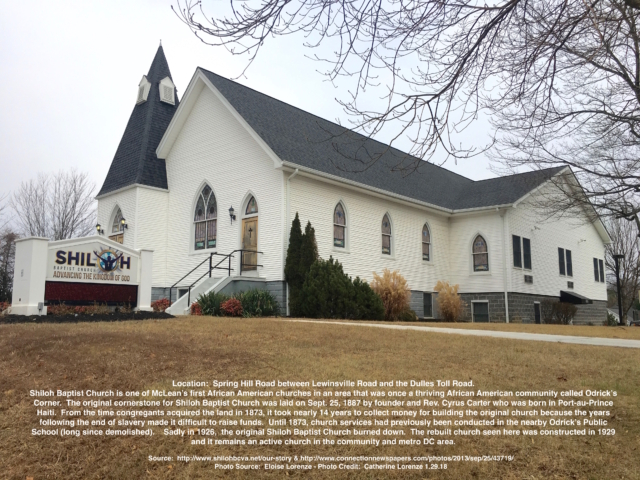
Shiloh Baptist Church, the beautiful church that sits on a rise just south of the intersection of Lewinsville Road and Spring Hill Road, celebrates 150 years of service to the community this year.
Founded in 1872 by Cyrus Franklin Carter, who also founded other churches in the area (First Baptist Church of Vienna and First Baptist Church Chesterbrook), Shiloh was central to the post-Civil War Odrick’s Corner Community. To read more about the history of the church, please visit shilohbcva.net/our-story.
To commemorate this special anniversary, Shiloh held a series of events including a community picnic in July, and a “Spotlight on Shiloh” event at the McLean Community Center in August. The celebrations culminated in a special worship service held on September 18.
The September 18 service, in addition to celebrating the church’s sesquicentennial, also recognized Rev. Dr. Robert F. Cheeks, Jr., and his wife, Minister Constance Cheeks, for their fifteen years of leadership to the congregation. It was a joyous occasion that included the presentation of a commendation from Fairfax County by Board of Supervisors Chairman Jeff McKay, and the reading of congratulatory messages from Governor Youngkin, the leadership of National Cathedral, and from Lewinsville Presbyterian Church which has been partnering with Shiloh Baptist in Bible study.
Shiloh Baptist is a member of Tysons Interfaith. At least four Tysons Interfaith communities were represented at the September 18 service. Pictured here at the service is Fazia Dean of Dar Al-Hijrah Islamic Center.
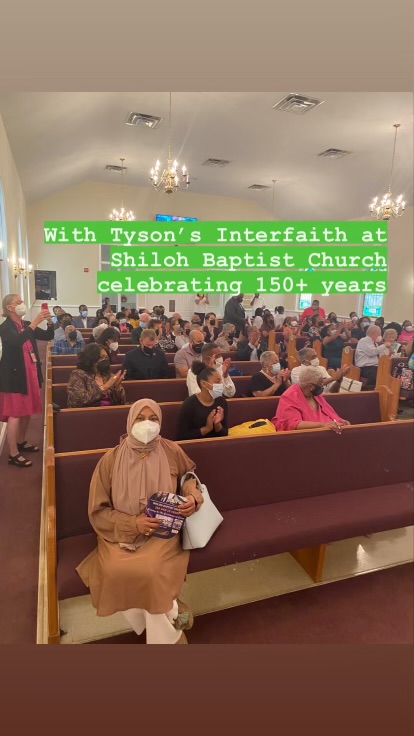
Tysons Interfaith congratulates Shiloh Baptist on their 150 years of enduring service to the local community. We look forward to continuing to partner with them to weave the values of spiritual connection, spiritual learning, mutual support, and community service into the fabric of the greater Tysons area.

A recent lead article in the Christian Science Monitor Daily really caught my attention. On September 15, editor Mark Sappenfield published a piece entitled “Butterflies, capitalism, and the golden rule.”
Butterflies, capitalism, and the golden rule

Editor
| When the world gathers in New York next week for the United Nations General Assembly, Kim Polman will be there to talk about butterflies – kind of. Ms. Polman is co-founder of Reboot the Future, an organization built on the idea that the golden rule – cherished in various forms by all human cultures – is the basis for societal and economic transformation. Ms. Polman is not alone in thinking capitalism needs a reboot. On one hand, capitalism has generated unprecedented wealth, lifting wide swaths of the world out of poverty. But it is also at the basis of what some call the “death economy” – extractive and exploitative practices built on competition run amok. She’ll be in New York to discuss the new book she helped write, “Values for a Life Economy.” The key to pivoting from an extractive, exploitative capitalism to one that embraces all and the planet is recognizing our deep interconnection. “We are all connected, and we are all responsible,” she says. “We need to wake up to the idea that we are not just here for ourselves.” She’s talking about nothing less than a shift in our economic paradigm. From the days of Adam Smith, capitalism has been about how competition holds our lower natures in check. Can we really expect more of ourselves as humans? That’s where the butterflies come in. When the caterpillar starts its metamorphosis, its cells actively resist. It tries to stop the process. “But the cell that holds the vision of the butterfly is innate in the caterpillar,” she says. The ability to transform is already there, and it only becomes active under duress. For humans, she says, that visionary cell is the golden rule – the innate, natural impulse to treat others and the world the way you would wish to be treated. “Our work,” she says, “is to reach a tipping point.” |
Isn’t this a wonderful thought to be discussing at the United Nations? An economic paradigm shift based on a deeper understanding of the Golden Rule.

Over 40 years ago the United National General Assembly established the International Day of Peace. In 2001 they unanimously clarified the day as being dedicated to strengthening the ideals of peace among all nations and peoples of the earth. This year’s Day of Peace theme is End Racism. Build Peace
With all the serious challenges to peace around the world, and right here in the US, Tysons Interfaith will highlight the 2022 International Day of Peace (September 21, 2022) with a continuation of our Oneness of Humanity series.
The Oneness of Humanity series began in the summer of 2020, when Tysons Interfaith hosted an on-line discussion about the concept of the “Oneness of Humanity,” and what it means from different faith traditions. In the ensuing months, we also explored “Since we are one, how do we deal with race?” and “Do you feel a call to take action (to build an equitable society)?” The series has continued since 2020, exploring topics of common interest to people of all faith traditions and spiritual practices.
The title of our September 21, 2002 Oneness event is: Building Peaceful Communities, Promoting Mutual Respect: A Call to Action. The event will be held on Zoom from 7:00 – 8:30 pm, and will be facilitated by Dara Feldman, an educator, international speaker, author and founder of Virtues Matter. We will explore learning language and practical skills to promote peace, and how to recognize virtues in others to build/repair relationships and foster mutual respect. We hope you will join us!
To register and learn more about this event, please visit tysonsinterfaith.org/iwe-event/building-peaceful-communities/.
This blog post is the expressed opinion of its writer and does not necessarily reflect the views of Tysons Interfaith or its members.
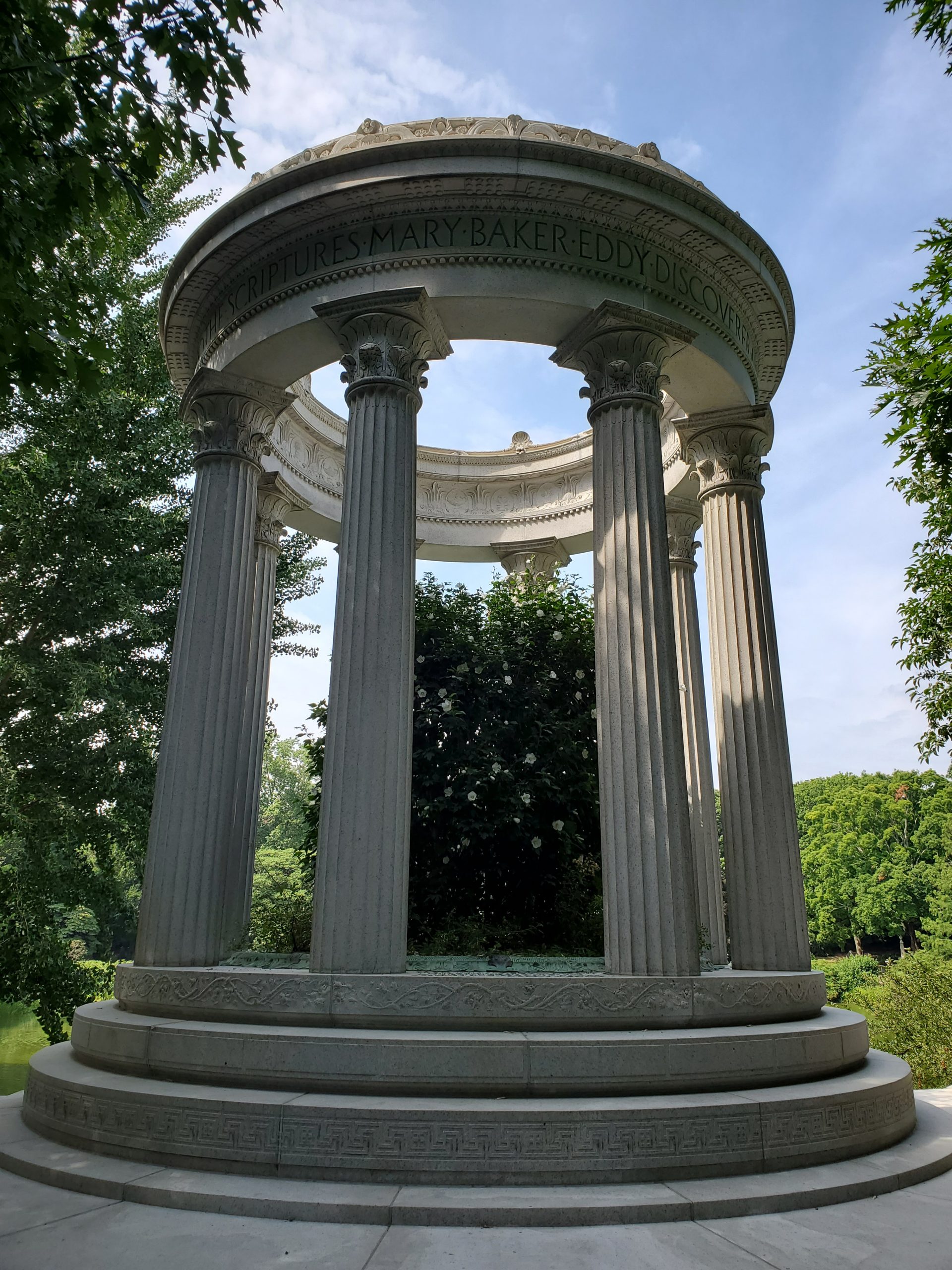
I recently visited Boston to visit my brother, and among a few other outdoor things, we visited Mt. Auburn Cemetery. Designed by Frederick Law Olmstead, who also designed Central Park, it is a beautiful array of trees, plants, ponds, and a stunning view of downtown Boston. Several luminaries are honored there, including Longfellow, Winslow Homer, Julia Ward Howe, and Oliver Wendell Holmes Sr. But three of the memorials in particular caught my eye.
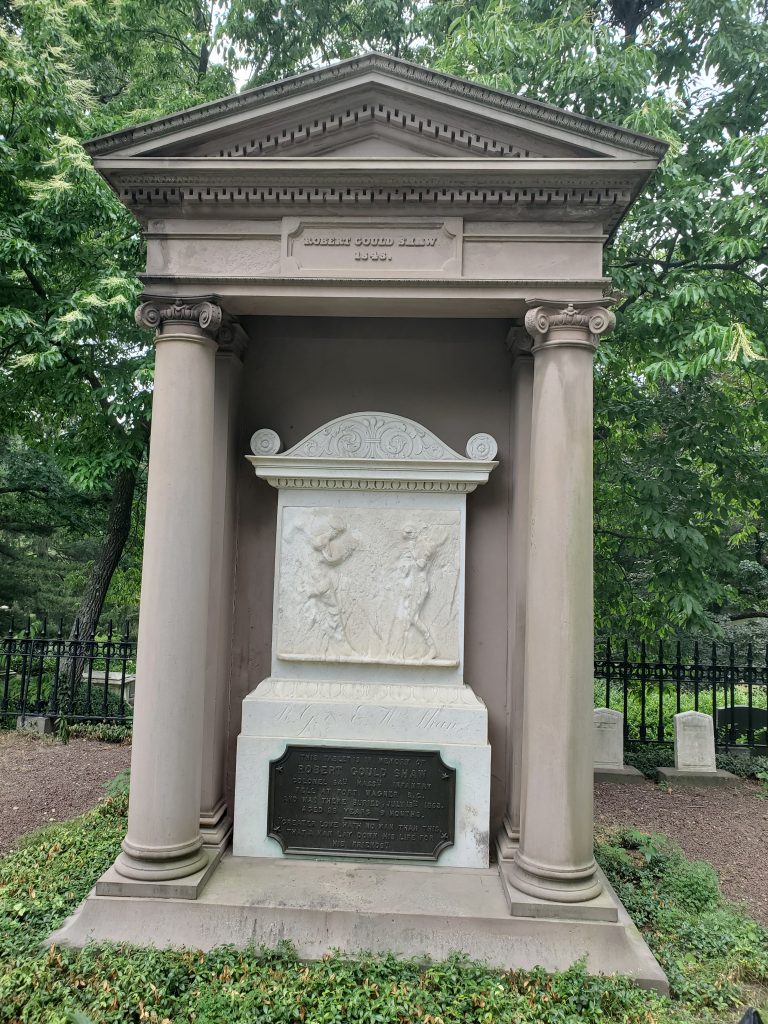
Robert Gould Shaw, born into a prominent Boston abolitionist family, accepted command of the first all-black regiment of the Civil War, the Massachusetts 54th, at age 25. As featured in the movie Glory, Shaw fought for the interests of his troops, and for their opportunity to participate seriously in the war. They got that opportunity in the bloody Battle of Fort Wagner, South Carolina, in which Shaw and many in his regiment were killed. The confederate general returned to the Union army the bodies of all Union officers that were killed, except for Shaw, since he commanded a black unit. Shaw was buried with his troops in a mass grave. Shaw’s father was proud of that fact, stating, “We would not have his body removed from where it lies surrounded by his brave and devoted soldiers . . . We can imagine no holier place than that in which he lies, among his brave and devoted followers, nor which for him better company – what a body-guard he has!” The memorial to Shaw pictured below was erected in Mt. Auburn Cemetery, where some of his relatives are buried. There is also a famous sculpture of Shaw and the 54th Regiment in the National Gallery of Art.
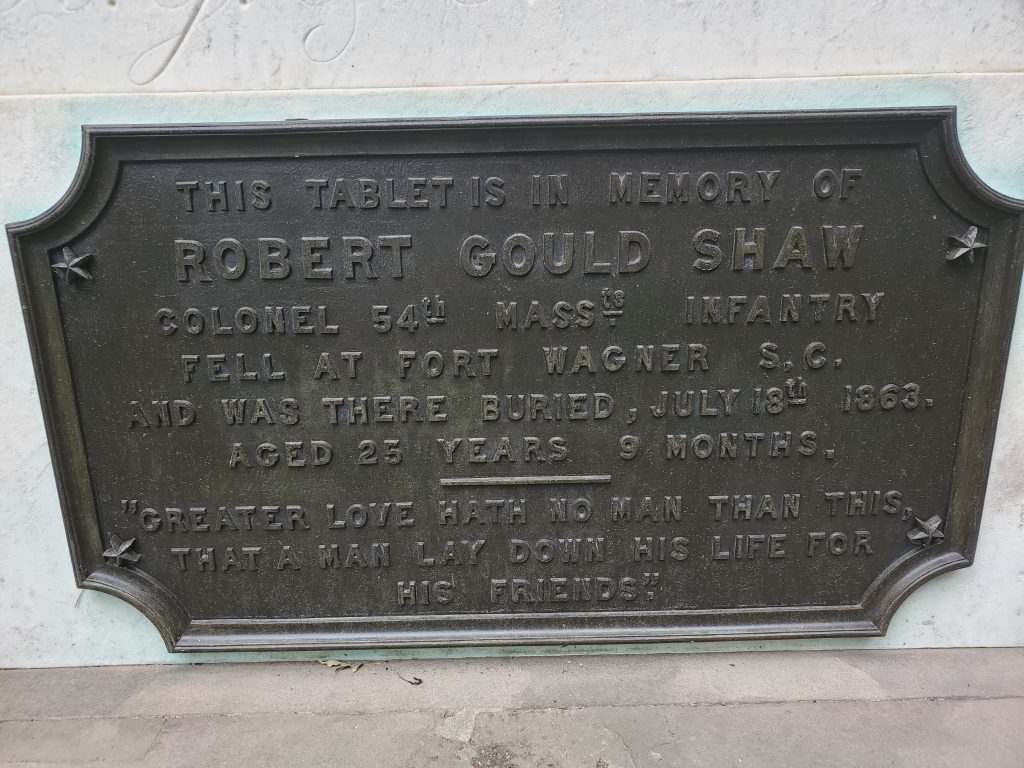
Dorothea Dix is memorialized by one of the plainer markers in the cemetery, which is fitting for someone who was a tireless and unselfish reformer for others, even though she suffered from numerous physical and mental health challenges of her own. She grew up in Worcester, Mass. In 1840-41, Dix did a statewide investigation and report of treatment conditions for the mentally ill in Massachusetts, resulting in expanded hospital facilities in the state. She did similar studies in many other states, including New Jersey, New Hampshire, Louisiana, and North Carolina, as well as Scotland and Nova Scotia. While facilities remained inadequate, her tireless activism helped improve care for the mentally ill. She was also appointed Superintendent of Army Nurses in the Civil War, overseeing over 3,000 nurses, though her strong views sometimes clashed with other leaders. Among other things, she encouraged her nurses to provide treatment to all those suffering. One of her nurses stated, “Many of these were Rebels. I could not pass them by neglected. Though enemies, they were nevertheless helpless, suffering human beings.”
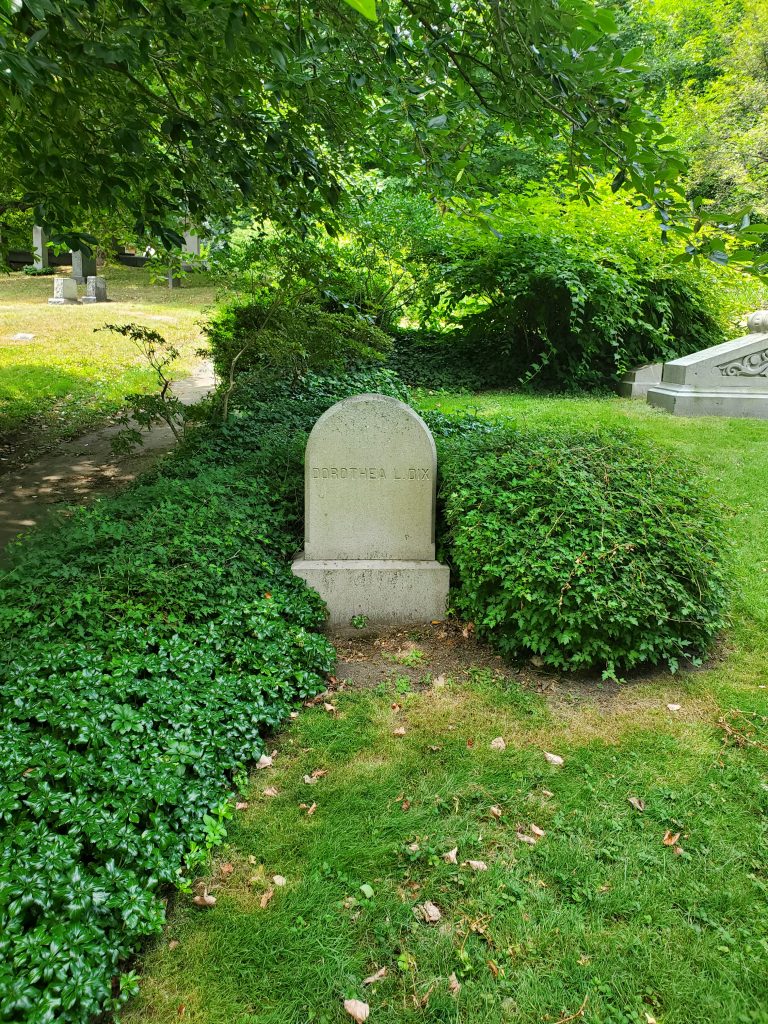
Mary Baker Eddy led Christian Science, which is part of the Tysons Interfaith group. She is honored by a beautiful monument at the side of a beautiful wooded pond. Eddy contributed greatly to American religious thought in the 19th century, and the Christian Science Monitor continues to be a thoughtful and influential publication.
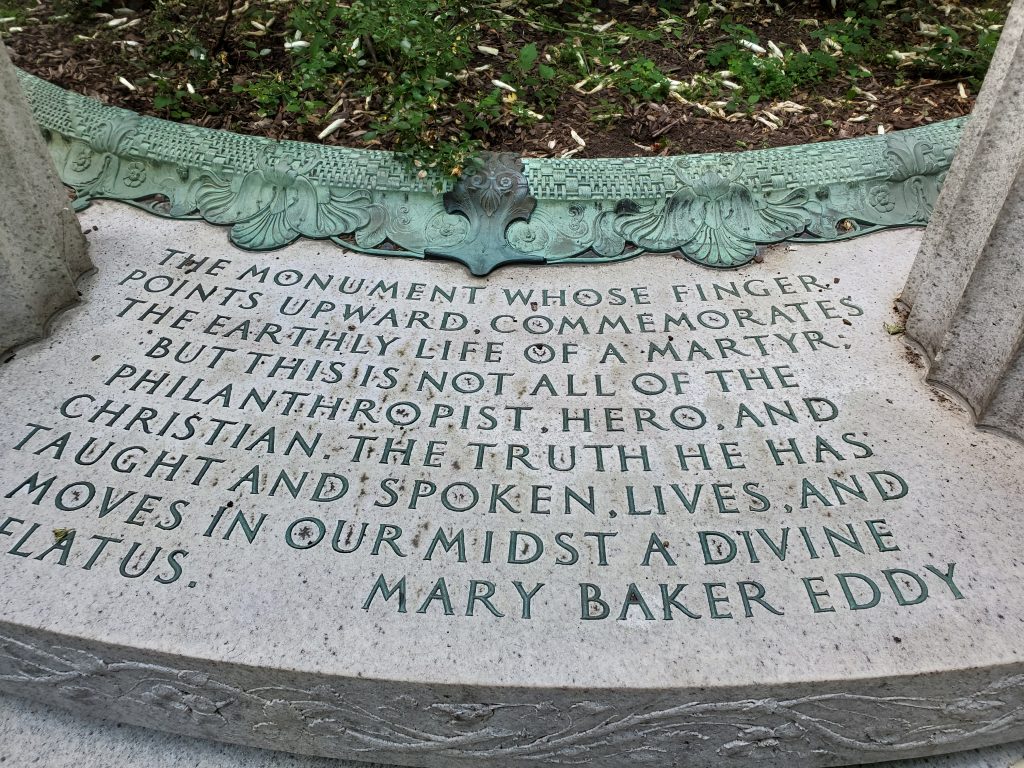
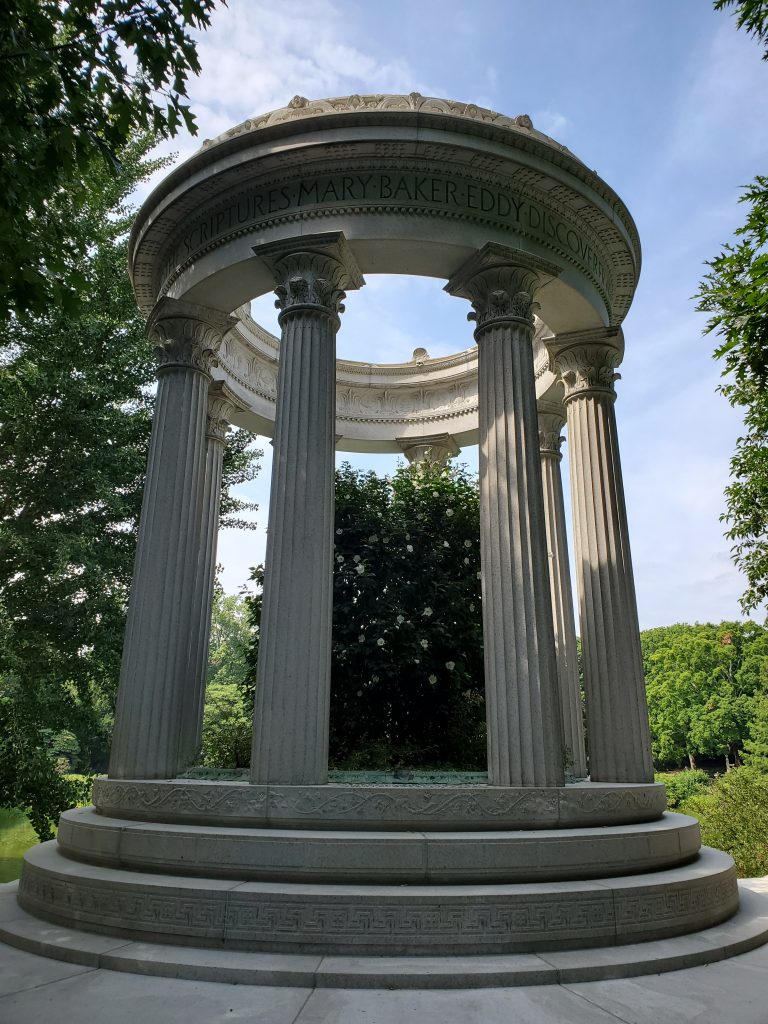
This blog post is the expressed opinion of its writer and does not necessarily reflect the views of Tysons Interfaith or its members.

Over 40 years ago the United National General Assembly established the International Day of Peace. In 2001 they unanimously clarified the day as being dedicated to strengthening the ideals of peace among all nations and peoples of the earth. The theme for this year’s Day of Peace is End Racism. Build Peace.
For the 2016 United Nations International Day of Peace, Centers for Spiritual Living formally recognized the Collective Meditation for Peace Initiative as an integral and essential element of our organization. Its driving purpose is to raise the consciousness of peace around the world.
So, what are we doing about it?
The Collective Meditation for Peace Initiative coordinates the weekly Heart of Peace Meditations on Facebook every Monday afternoon at 1:00 PM MT. Team members are “vision led” to provide an array of meditation experiences throughout the year.
The Heart of Peace team invites everyone to take a deep dive into their spiritual practices, committing to daily peace prayers in total confidence that we do have the power to change the world using affirmative prayer – Peace shall prevail! The team is fostering the emergence of a world in which compassion and empathy overcome suspicion and hatred. A world that we can truly be proud of.
Our next event “One World, One Lover, One Peace” is on United Nations International Day of Peace, September 21st the 2022 on Facebook.
To achieve enduring Peace we collaborate, connect and take actions collectively. The Heart of Peace team is always seeking ways in which it can engage people … to attract spiritual activists with a passion for peace. We began by becoming clear observers, honest evaluators and dedicated doers. We have discerned the components of peace and identified actions that synergistically bring about experiences of peace. In collaboration with other organizations, we produce events and promote those of other peace organizations and our communities such as the Global Chain Reaction for Peace created by the Center for Spiritual Living Geneva [Switzerland]. This past year we have featured the World Healing Peace Meditation, provided a Pause for Peace at the Centers for Spiritual Living 2022 Convention, produced a daily meditation guide posted on Facebook every day of the Season of Peace and Nonviolence, hosted World Labyrinth Day and the United Nations International Day of Peace.
Individually and collectively the Heart of Peace team members remain keenly alert to ways in which to remove obstacles to the free flow of peace around the world. Acknowledging that a lack of information and education about other cultures and traditions, has been one of the primary forces obstructing universal peace, team members have engaged with other organizations to break such barriers.
And, there are more ways in which Centers for Spiritual Living is bringing forth world peace …
Global Services Committee, in fulfillment of our Global Vision of “… a world in which we live and grow as One Global Family that respects and honors the interconnectedness of all life; a world where this kinship with all life prospers and connects through the guidance of spiritual wisdom and experience” works diligently worldwide connecting and nurturing global relationships. These connections make it possible for people to learn about other cultures and make personal connections – essential components of world peace.
Our Diversity Equity Inclusion Committee is dedicated to working toward a world that embraces and celebrates diversity and eliminates all expressions of prejudice in alignment with the United Nations 2022 theme of “End Racism. Build Peace.”
We envision a world that works for everyone and for all creation and are committed to doing our part to make peace magnificently ordinary rather than something exceptional to be achieved.
(Coming next: International Day of Peace, September 21, 2022 – What Tysons Interfaith is Doing to Support It)
###
United Nations International Day of Peace 2022 Theme: “End Racism. Build Peace.”
Look for Peace Day activities in your own community and around the world: *Minute of silence at 12 noon (all time zones) *Peace education events *Intercultural and interfaith dialogues *Workshops on the UN Peace Day theme *Meditation and prayer *Planting peace poles *Community gatherings *Vigils *Concerts and festivals
This blog post is the expressed opinion of its writer and does not necessarily reflect the views of Tysons Interfaith or its members.

Over 40 years ago the United National General Assembly established the International Day of Peace. In 2001 they unanimously clarified the day as being dedicated to strengthening the ideals of peace among all nations and peoples of the earth. This year’s Day of Peace theme is End Racism. Build Peace.
It is a common practice in the US is to declare days in recognition of this or that. For years I have found that confusing when it comes to something like peace. The declaration of twenty-four hours dedicated to something such as cease-fire and non-violence, begs the question: Is it then okay to be horrid and hateful during the other 8,736 hours in a year? I know we must start somewhere, and one day is better than no days. I feel we need to be clear about our intention: we want more! We are called to do everything within our power to bring about its fulfillment. We need to be firm and not accept anything less than its fulfillment lest we give in and tolerate something less than real peace. We must be willing to go full out for all peoples – all creation – to experience the components of peace.
This year, the United Nations is acknowledging that achieving true peace entails much more than laying down arms. It requires the building of societies where all members regardless of race can flourish.
It has long been a stand within Centers for Spiritual Living that we are called to create a world that works for all. This involves creating a world in which there is equity, in which all people are treated equally, regardless of their race, gender, orientation, age, ability or other unique attributes. We envision all people, all beings, and all life as expressions of God.
Our Global Vision doesn’t just suggest that we should be nice to one another. It clearly states that we envision “A World That Works for Everyone”- a world of peace and harmony, enfranchisement and justice – and that this is our work to do. It doesn’t suggest that mediocre is okay. It calls us to commit to it and lean into its fulfillment!
As Secretary-General António Guterres has said: “Racism continues to poison institutions, social structures, and everyday life in every society. It continues to be a driver of persistent inequality. And it continues to deny people their fundamental human rights. It destabilizes societies, undermines democracies, erodes the legitimacy of governments …” In the presence of such forces, collective peace is not experienced.
We each have a role to play in fostering peace. Tackling racism and other demonstrations of prejudice are crucial and require our collective action.
In furtherance of the United Nations dedication to strengthening the ideals of peace, both within and among all nations and peoples, the Secretary went on to say, “We are called to dismantle the structures that entrench racism in our midst. We can support movements for equality and human rights everywhere. We can speak out against hate speech – both offline and online. We can promote anti-racism through education and reparatory justice.”
Stay tuned as we explore local efforts to promote anti-racism and sustainable peace in our homes and communities.
This blog post is the expressed opinion of its writer and does not necessarily reflect the views of Tysons Interfaith or its members.
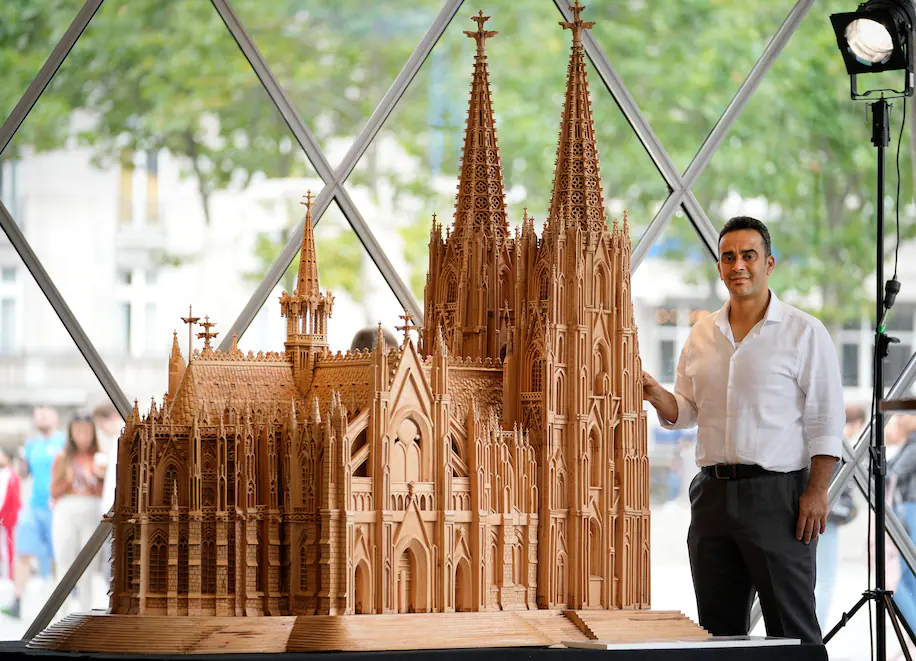
An AP story that ran recently in the Washington Post touched us deeply.
We shared the story with our Tysons Interfaith colleagues who also found the story to be very uplifting. We share it again here for all to appreciate:
WASHINGTON POST, June 27, 2022
www.washingtonpost.com/kidspost/2022/06/25/
Syrian refugee spends 5,000 hours carving model of German cathedral
Fadel Alkhudr, a woodcarver who fled war in Syria, was charmed by the cathedral in Cologne, his new home.
Fadel Alkhudr from Syria poses Monday with his wooden model of the Cologne Cathedral on display in Cologne, Germany. Alkhudr, a woodcarver from Aleppo, Syria, fled the war in his home country and arrived in Cologne in 2015. He became fascinated by the cathedral and decided to carve a model. (Martin Meissner/AP) Fadel Alkhudr from Syria poses Monday with his wooden model of the Cologne Cathedral on display in Cologne, Germany. Alkhudr, a woodcarver from Aleppo, Syria, fled the war in his home country and arrived in Cologne in 2015. He became fascinated by the cathedral and decided to carve a model. (Martin Meissner/AP)
When Syrian refugee Fadel Alkhudr arrived in Germany in 2015, the first thing he saw when he stepped out of the train in Cologne was the city’s majestic cathedral.
Alkhudr, 42, became so fascinated by the famous landmark on the Rhine River with its twin spires and elaborate ornaments that he spent hours looking at it. He took photos of it, drew sketches and eventually started carving a wooden model.
For more than 2½ years — or about 5,000 hours, he says — Alkhudr worked on creating a 6½-foot-tall copy of the structure in a small basement that he uses as a workshop in the city.
Alkhudr, who is Muslim, said he developed such a close connection to the Catholic cathedral that at some point it felt like the building became a part of him, “like it’s a dear friend to me.”
The Syrian, who learned carving from his father at the age of 13, first fled to Turkey and then to the western German city of Cologne after his family’s woodcarving business in Aleppo was destroyed during the war in Syria. He said he’s often asked if it didn’t feel strange for a Muslim to dedicate himself to Germany’s most famous Christian house of worship.
Not at all, he says, because growing up in Aleppo before the civil war, he had Muslim and Christian friends, and customers from different religions who came to buy wooden art at the family store.
“When we were in Aleppo we used to have … no issues between a mosque and a church,” the father of five recounts. “Our neighbors were Christian and we are Muslims. We used to invite each other into our homes and there were no problems.”
Alkhudr is one of more than 1 million migrants who came to Germany from Syria, Iraq and Afghanistan in 2015-2016, escaping war, destruction and poverty in their home countries. He first worked odd jobs to make a living, brought his family over in 2017, and, since 2019, focused on creating the cathedral model. He hopes that in the future he can also make a living in Germany as an art carver.
Alkhudr used hard beech wood and 50-year-old tools from Syria that his father had passed on to him. The end result was 6½ feet in height and length, and about 4½ feet in width.
The original cathedral is 500 feet tall and took more than 600 years — from 1248 to 1880 — to complete. It’s a United Nations World Heritage Site and hosts the Shrine of the Three Kings, believed to contain the bones of the “Three Wise Men.” The cathedral is one of Germany’s top tourist attractions and one of the oldest and most important pilgrimage sites of Northern Europe.
Alkhudr’s delicately chiseled work is on exhibit at the cathedral’s Domforum visitor center just across from the original. The Syrian hopes that he can present his woodwork in other cities, too, and thus spread what he sees as the cathedral’s unifying message.
“For me, the cathedral is a home for all people,” he said.
This blog post is the expressed opinion of its writers and does not necessarily reflect the views of Tysons Interfaith or its members.
